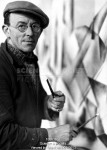
John Tunnard
British, 1900-1971
Last Day, 1944
pastel, wash, gouache, crayon, pen and ink on paper
15 × 22 in.
SBMA, Gift of Wright S. Ludington
1947.13.12

John Tunnard works on his mural for the Regatta Restaurant at the Festival Of Britain, 1951
"One day a marvelous man in a highly elaborate tweed coat walked into the gallery. He looked a little like Groucho Marx. He was as animated as a jazz-band leader, which he turned out to be. He showed us his gouaches, which were as musical as Kandinsky's, as delicate as Klee's, and as gay as Miró's."
- Peggy Guggenheim [On John Tunnard]
COMMENTS
John Tunnard loved and was most comfortable in the natural world of the English countryside. In making use of strongly technological images, he created a personal synthesis of the natural world of science and of art.
The scion of an old but impoverished country family, Tunnard had a special fondness for his native Cornish coast. He was a wildfowler and an amateur entomologist. His artistic training was the conventional one of the Royal College of Art, which he attended at the same time as Henry Moore. He married a fellow student with whom he collaborated on textile design (nonfigurative) and production. He was a devotee of jazz (an interest he shared with Mondrian), who appreciated the implications of its improvisational basis for the visual arts.
Primarily through exhibitions in London, Tunnard was influenced by the Constructivist, Abstract, and Surrealist movements, although he never aligned himself with any one of them. Especially overt is the influence of Miro, whom he possibly met when he travelled to Mallorca in 1935.
Tunnard's works in the early Thirties were rather Romantic landscapes of the Cornish coast, but by the 1939 Peggy Guggenheim show, his work was all non-representational. Tunnard accounted for that transition:
First, I suppose, I was interested in merely trying to put down what I saw or thought I saw. Then, after that, I was more interested in the dramatic content of the landscape or whatever it was that I was painting, and then, more particularly, not so much with the literary dramatic content but with the geometrically dramatic content .... Of course, I got to the stage when, confronted with a landscape, I felt that I could not be bound by the things that I saw, and naturally the only thing to do was to invent. As soon as I started inventing I found that it was so much more exciting, and that inventing came gradually into what is called non-representational painting. 1
Gouache was Tunnard's preferred medium, which seems appropriate to the interpenetration of masses and the intersection of planes so obvious in from nature work. As Herbert Read expressed it, although Tunnard took his inspiration from nature, it was his sensitivity to its "inner morphology" which allowed his unique statement.2
1 Cited by Mark Glazebrook, "John Tunnard--Development and Influences," in exhibition catalogue, John Tunnard, Royal Academy of Arts, Arts Council, London, 5 March - 11 April, 1977, p. 22
2 "The World of John Tunnard," reprinted in exhibition catalogue, op. cit., p. 54.
Bibliography
Glazebrook, Mark. "John Tunnard--Development and influences," pp. 13-36.
Glossop, Rudolph. "John Tunnard: A Personal Appreciation," pp. 8-12.
Read, Herbert. "The World of John Tunnard," pp. 52-54, reprint.
Thwaites, John Anthony. "The Technological Eye," pp. 47-51, reprint.
- Exhibition catalogue, John Tunnard, Royal Academy of Arts, Arts Council, London, 5 March-11 April, 1977
SBMA CURATORIAL LABELS
Tunnard studied textile design at the Royal College of Art and after graduating in 1921 worked as a designer for several manufacturers as well as John Lewis, the department store. Although he continued as a designer, painting became an increasingly important activity for him. His work was strongly influenced my surrealist motifs. In the late 1930s he met the heiress Peggy Guggenheim and had his first exhibition in 1939 at Guggenheim Jeune, her London Gallery.
- British Modernism Whistler to WWII, 2016
This image in mixed media is typical of Tunnard's work during the 1940's and 1950's, when he used a variety of techniques for rich textural effects. Permitting some automatism in the development of his forms, he admitted the influence of Paul Klee and such continental surrealists as Miro but was only loosely allied to the English surrealists. The hints of modern technology in the sculptural shapes set in vast arid spaces, derive from the artist's vision of an alliance of art and technology.
John Tunnard's Last Day (1944), with its skeletal forms and Surrealist-inspired landscape, suggests both the collapse of civilization and renewal. From a swampy foreground full of battered structures, a few sharp edged forms emerge, pristine and new. On a distant shore, a white palace stands waiting for two abstracted figures making their way toward it from the water's edge. Tunnard's work expresses a timeless state beyond good and evil, beyond the reach of nationalism and political boundaries.
From: Bold Strokes and Quiet Gestures, SBMA, p. 63
